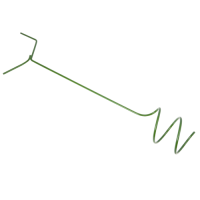Q – What is an ideal pH of compost?
A – Excessively high acidity or alkalinity levels can hinder the efficiency of worms and microorganisms at work in a compost bin. The ideal conditions for maximum efficiency is a neutral reading of 7.0. The composting process often leads to more acid levels in the materials. It is a good idea to test your compost every so often, either with litmus paper or with a meter. If your reading is too acidic, add a good sprinkle of Tumbleweed Worm Farm & Compost Conditioner, finely crushed eggshells, or dolomite, mixing into compost.
Q – I often have too much fruit and vegie waste for my home composting system to handle. Is there anything we can do to speed up the composting process?
Aerating the compost will help to speed up decomposition. As it adds more oxygen into the materials, it creates a more aerobic system which helps keep problems at bay. I use the CompostMate tool which makes it easy to fluff up the compost. If you don’t have one of those then mix with a garden fork or similar. Finely chopping or blending your scraps before you put them in will help them break down faster. It is also important to keep the moisture level right – not too wet and not too dry will help the microbes and worms to be at their working best. Using only fruit and vegie waste will likely result in a very wet compost, so balance it up with shredded paper and plain cardboard, which will also bring much needed carbon to the system. Lastly check the pH levels, as excessively high levels of acidity or alkalinity can slow down the composting process.
Q – I started a compost bin and now it’s full of worms. What is the best way to get the compost out of the bottom without removing the worms?
It can be tricky to remove all the worms, even with a compost system designed specifically to encourage a worm free product. Additionally there may also be worm capsules which will hatch later. If I specifically need no worms in my compost, then I will stack it onto a very fine mesh in the sunshine for a couple of weeks, which will allow the worms to drop out of the bottom, and for the worm capsules to hatch. Some of the fine compost will also drop through with the worms with this method. If you don’t have fine mesh, then you can use a wheel barrow or large box in the sunshine, and heap the compost. The worms will tend to travel downwards, as they do so you keep removing the hopefully worm free compost from the outside of the heap.
If you don’t need worm free compost, then just use your worm laden compost in the garden and let nature take its course. Worms are added goodness to your soil.
Q – My compost heap is slimy and smelly, what can I do?
A compost heap with this sort of problem usually has had too many nitrogen rich ingredients added, and is holding too much water and not enough air to allow the composting microbes to work at their best. Firstly, adding more carbon rich materials in the form of shredded paper, dried leaves, torn corrugated cardboard or straw will help to balance the nitrogen content. Stirring up the compost every few days with a garden fork or shovel, or a specially designed spiral shaped tool as pictured below, will help to open up the compost to more air.

